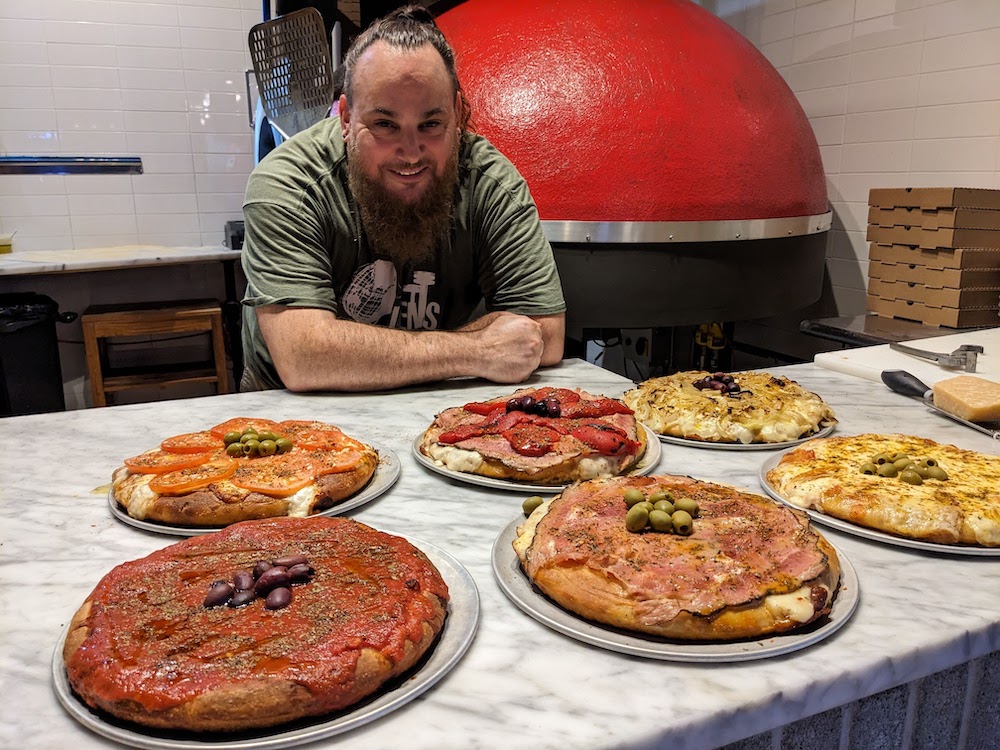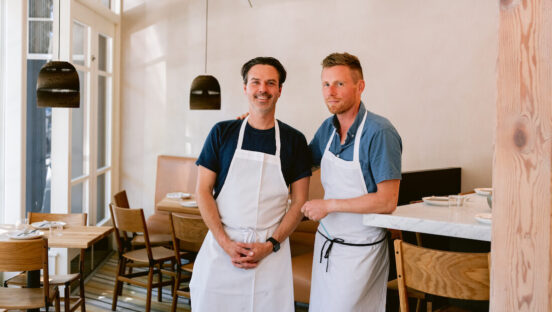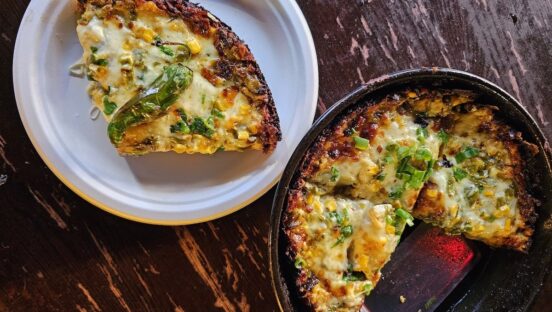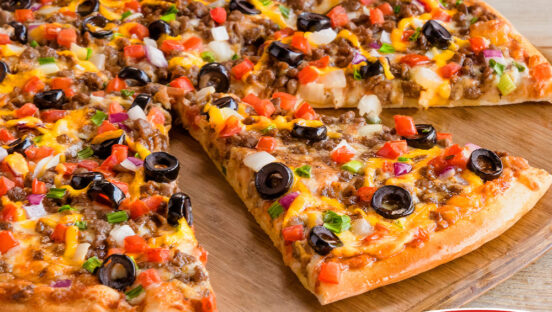By Charlie Pogacar
Fernando Greco has lived in New York City for 40 years, and in many ways, he is as New York as it gets. The tattooed, bearded school teacher is passionate, talkative—and, most of all, a lover of pizza.
In his thick Brooklyn accent, Greco identifies pizza as one of two things that link him most intimately to his home country of Argentina—the other, of course, is soccer. He is a fervent supporter of his home team, Racing Club de Avellaneda. He quite literally fainted—twice—as his home country was en route to a thrilling victory in the 2022 World Cup Final last December.
Related: Chef Wesley wows Floridians with Brazilian-style pizzas
But this story is about pizza. Argentina’s style of pizza is a unique, thick-pan variety with a focaccia-like dough and toppings piled high. Most Argentine pies contain very little tomato sauce.
Greco possesses a feverish desire to spread the word about his home country’s under-the-radar export, and the first thing he wants everyone to know is that while the terms “fugazza” and “fugazzeta” have become synonymous with Argentine pizza, that’s not really correct. Yes, that’s a popular type of pie in Argentina—made with loads of cheese, onions and sometimes olives—but it’s not the only kind.
“That just refers to one style of toppings,” Greco said. “It would be like saying ‘pepperoni pizza.’”
These days, Greco’s desire to educate the masses takes the form of pop-ups all over the city where he cooks Argentine pizzas. He even qualifies as a pizza influencer on Instagram: His account, @OG_papafern, has over 22,000 followers. Greco describes himself as the self-anointed “king of the cheese pull,” something he views as part art, part science. He’s happy to give out tips on how to perfect the social-media-friendly stunt. “There are several things that go into executing a great cheese pull,” Greco said. “First, it has to be a whole-milk cheese. It also needs to not caramelize, or burn, so it stays gooey. And there has to be a lot of cheese—like, a lot.”
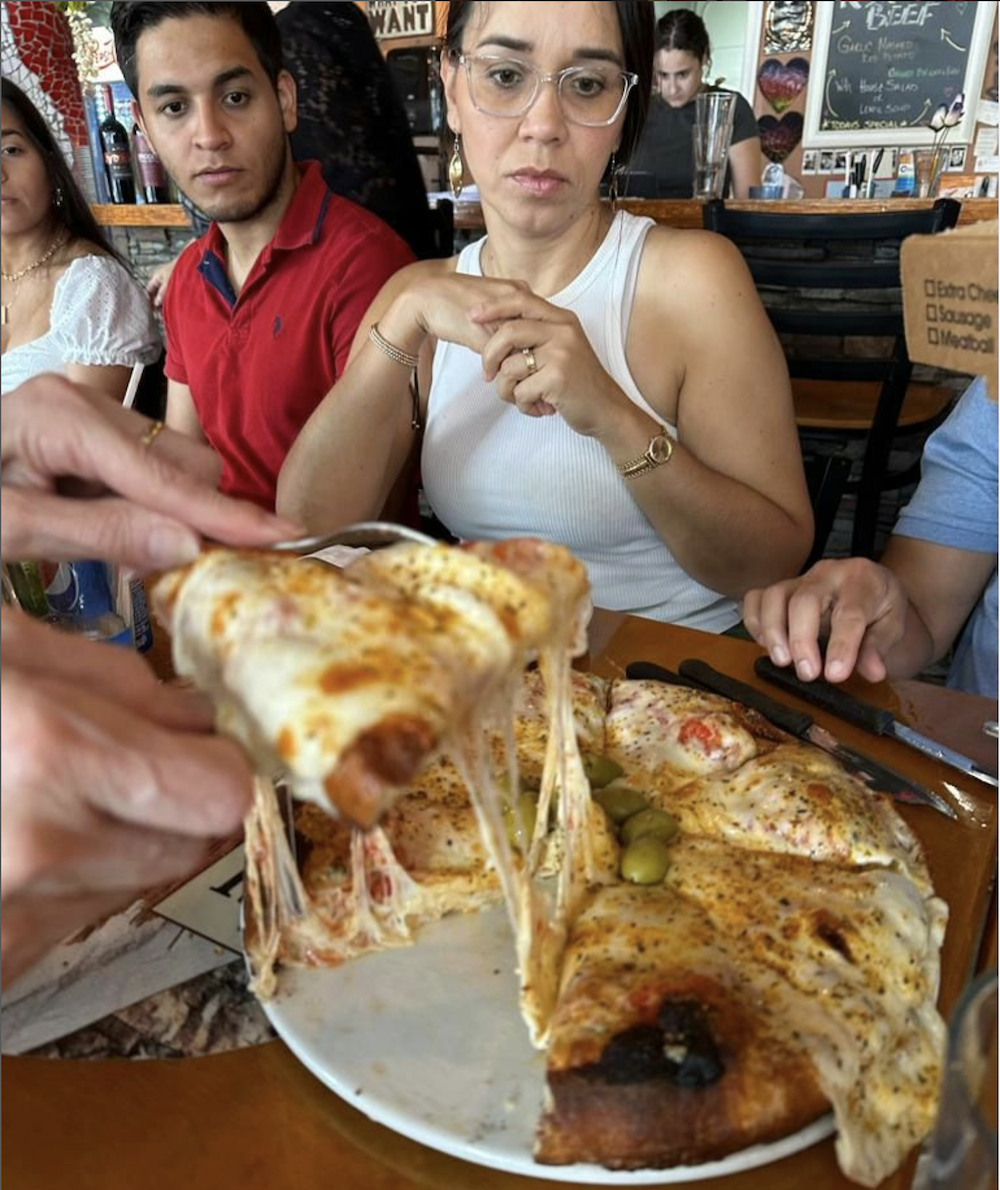
Making pizza is Greco’s gig at night and on the weekends. During the day, he’s a paraprofessional—or an assistant classroom teacher—in the city’s public schools system. He specifically teaches children with special needs, showing up in casual dress and finding ways to relate to the children, many of whom are immigrants, or the sons and daughters of immigrants, themselves.
“My job doesn’t pay enough to live in New York City,” Greco said. “But I don’t want to give it up. The supplemental income from making pizzas is great—my money from my day job goes to expenses. My pizza money is my spending cash.”
Before he himself was schooled, as he describes it, “on the streets of New York,” Greco grew up in a pizzeria back home in Buenos Aires. His father owned a shop called Traka Traka that sold pizza and empanadas. As a young boy, Greco was fascinated by the cooking and baking process, and he remembers playing with dough in his father’s pizzeria.
When inflation spiked in the 1980s, the average Argentinian’s buying power all but vanished. Things like wood suddenly became too expensive—Greco’s father had nothing to burn in his shop’s pizza oven. He began using a literal flamethrower to cook his empanadas and pizzas before ultimately deciding to relocate his family to the U.S.
When a young Fernando Greco landed in New York City in 1983, he didn’t know a word of English. He has a clear memory of the moment, though: He was impressed by the stretch limos that awaited arrivals. He said that fascination with displays of wealth is actually related to Argentine pizza in a roundabout way.
Greco is now something of a scholar in regard to Argentine pizza—he’s currently researching writing a book on the topic, specifically focusing on the process of Italians immigrating to Argentina and the food they brought with them. He notes that, generally speaking, immigrants tend to leave home because economic times are tough. As a result, “a lot of times, when an immigrant moves, they want to show off their wealth once they’ve made a little bit of money,” Greco said. “So, for some groups, that means buying expensive jewelry or expensive houses. But the first way of showing it, in Argentina, is through food.”
Greco said authentic Argentinian pizza is characterized by a “more is more” type of philosophy: If a pie has 500 grams of dough, then it’s going to have at least 500 grams of cheese. He estimates that a typical New York-style 18″ pizza uses less cheese than the average 12″ Argentine pizza—that’s how decadent an Argentine pie is.
“Everything is abundant,” Greco said. “It’s not only with pizza—if you’re having a barbecue for two people, in Argentina, you make enough food to feed six people. And we kept those traditions alive as they were passed down.”
Perhaps for these reasons, when Greco first arrived in New York, he didn’t like the famous local pizza. He says he was a picky eater as a kid, and the only thing he could find in the U.S. that remotely resembled the pizza he was familiar with was an all-cheese, Sicilian-style pie. He could still get his favorite pizza, though—his dad would cook it for him at home, just the way he remembered.
Related: An Expert’s Guide to 9 Classic Regional Pizza Styles
Later, when Greco’s dad moved back to Argentina in the mid-1990s, Greco took matters into his own hands. He began experimenting and cooking pizza. He would create enormous spreads of pizza, empanadas, and other Argentine food for friends and family—something he did for decades after his dad left.
In those days, Greco would make dough out of a commercial yeast, prepping it in the morning to be ready by nightfall. The pizza received rave reviews in his inner circles, but as Greco began to travel more as an adult, he noticed different ways of doing things, and he wanted to learn. He was especially blown away by the pies at King Umberto, a pizzeria on Long Island. He became friendly with the chef there and began picking his brain.
View this post on Instagram
Greco eventually got connected with a series of mentors that he credits with helping take his homemade pies to the next level: Felix Toro of Happy Bull Pizza; Nicole Russell at Last Dragon Pizza; Serhan Ayhan at Next Level Pizza; and Nino Coniglio of Brooklyn Pizza Crew.
He started to see more refined ways of making dough, methods that would make his Argentine pizza stand out that much more. When friends and mentors sampled his new-and-improved pies, they urged him to cook them for the masses. It was a unique product, unlike anything else out there at the time. There was just one problem: he didn’t know if the average New Yorker would want to eat Argentine pizza.
“At first, I was hesitant,” Greco said. “If you read anything online about Argentinean pizza, you’ll find that it’s a polarizing topic: People either love it, or they hate it.”
Finally, in 2019, he gave cooking for the public a whirl. It was at the annual New York Pizza Festival held in the Bronx, where attendees purchase punch cards and try slices at different vendor tents. This is where Greco realized he really had something.
“People were limited to 10 slices, and here are all these other people making pizza,” Greco said. “And I would watch their reaction and hear them telling other people, ‘Hey, you have to go try this.’ And some of them would even come back and use multiple punches just to have more of my pizza. That reaction was really unbelievable.”
Since then, Greco has gravitated toward doing pop-ups at breweries and area pizzerias like Wheated (Brooklyn), Beebe’s (Queens) and D’amore (Rockaway Beach), and has even appeared at the place that started his latest chapter, King Umberto. Greco’s expanding, too—he will soon do his first out-of-state popup, at The Italian Joint in Kissimmee, Florida.
View this post on Instagram
Still, Greco’s not quite ready to give up his day job. Working with children simply means too much to him. With so many children impoverished in inner-city Queens, where he now lives, it’s a place where he feels he can have the biggest impact. If introducing the world to Argentinian pizza is a passion of his, teaching children is more like a calling.
“There are kids that some people think are too problematic,” Greco said. “They’re the kids who don’t get paid enough attention in the classroom. The ones that need the most help sometimes get less help, but I can change that. I can work with them one-on-one, or one-on-five, and help them learn what they need to learn.”
Greco said he does have an idea for what his pivot into doing pizza full-time would look like. It might start with a food truck—he even has a business partner in mind, a fellow teacher who is close to being able to collect a nice pension from the state in retirement. If he pursues it, he has no doubt who his first employees would be.
“My old students would be the ones I’m hiring,” Greco said. “I live in the same neighborhood where I work. It’s a heavy immigrant population. When I work with them, they’re in elementary school, they’re cute little kids. When they get older, society makes them tough or makes them want to be tough. I see a lot of them getting in trouble when they get older. Me, I go to work in a T-shirt, with tattoos—these kids think I’m cool, relatable. They are going to listen to me. That’s where I feel like I can make the biggest difference.”
Greco’s Instagram can be found at @OG_papafern. Greco also hosts an account dedicated specifically to his pizza pop-ups @la.pizza.clandestina.

